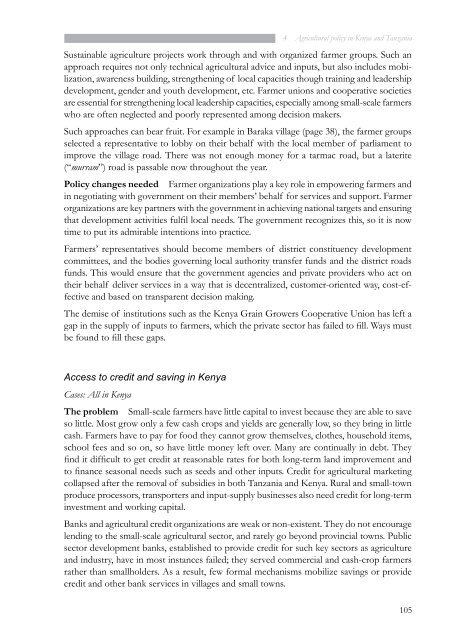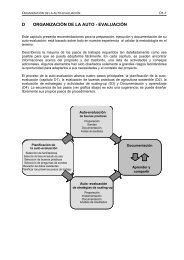cases from tanzania - Sustainet
cases from tanzania - Sustainet
cases from tanzania - Sustainet
You also want an ePaper? Increase the reach of your titles
YUMPU automatically turns print PDFs into web optimized ePapers that Google loves.
4 Agricultural policy in Kenya and Tanzania<br />
Sustainable agriculture projects work through and with organized farmer groups. Such an<br />
approach requires not only technical agricultural advice and inputs, but also includes mobilization,<br />
awareness building, strengthening of local capacities though training and leadership<br />
development, gender and youth development, etc. Farmer unions and cooperative societies<br />
are essential for strengthening local leadership capacities, especially among small-scale farmers<br />
who are often neglected and poorly represented among decision makers.<br />
Such approaches can bear fruit. For example in Baraka village (page 38), the farmer groups<br />
selected a representative to lobby on their behalf with the local member of parliament to<br />
improve the village road. There was not enough money for a tarmac road, but a laterite<br />
(“murram”) road is passable now throughout the year.<br />
Policy changes needed Farmer organizations play a key role in empowering farmers and<br />
in negotiating with government on their members’ behalf for services and support. Farmer<br />
organizations are key partners with the government in achieving national targets and ensuring<br />
that development activities fulfil local needs. The government recognizes this, so it is now<br />
time to put its admirable intentions into practice.<br />
Farmers’ representatives should become members of district constituency development<br />
committees, and the bodies governing local authority transfer funds and the district roads<br />
funds. This would ensure that the government agencies and private providers who act on<br />
their behalf deliver services in a way that is decentralized, customer-oriented way, cost-effective<br />
and based on transparent decision making.<br />
The demise of institutions such as the Kenya Grain Growers Cooperative Union has left a<br />
gap in the supply of inputs to farmers, which the private sector has failed to fill. Ways must<br />
be found to fill these gaps.<br />
Access to credit and saving in Kenya<br />
Cases: All in Kenya<br />
The problem Small-scale farmers have little capital to invest because they are able to save<br />
so little. Most grow only a few cash crops and yields are generally low, so they bring in little<br />
cash. Farmers have to pay for food they cannot grow themselves, clothes, household items,<br />
school fees and so on, so have little money left over. Many are continually in debt. They<br />
find it difficult to get credit at reasonable rates for both long-term land improvement and<br />
to finance seasonal needs such as seeds and other inputs. Credit for agricultural marketing<br />
collapsed after the removal of subsidies in both Tanzania and Kenya. Rural and small-town<br />
produce processors, transporters and input-supply businesses also need credit for long-term<br />
investment and working capital.<br />
Banks and agricultural credit organizations are weak or non-existent. They do not encourage<br />
lending to the small-scale agricultural sector, and rarely go beyond provincial towns. Public<br />
sector development banks, established to provide credit for such key sectors as agriculture<br />
and industry, have in most instances failed; they served commercial and cash-crop farmers<br />
rather than smallholders. As a result, few formal mechanisms mobilize savings or provide<br />
credit and other bank services in villages and small towns.<br />
105




